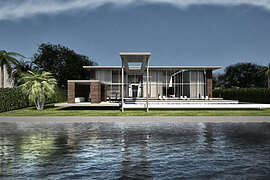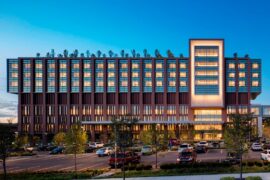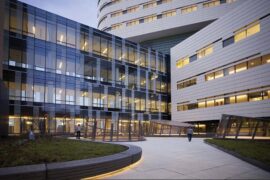Palace of the Parliament, Romania – Biggest Legislative buildings around the world
In the heart of Bucharest, Romania, stands a testament to architectural prowess and political significance—the Palace of the Parliament. Also known as the People’s House, this monumental structure is a beacon of grandeur, symbolizing the nation’s resilience and determination. This article delves into the intricate details of the architecture, planning, interior design, and urban layout that make the Palace of the Parliament a remarkable masterpiece.
A Monumental Marvel: Architecture Beyond Compare
The Palace of the Parliament is an architectural marvel that commands attention and admiration. Commissioned during the regime of Nicolae Ceaușescu, construction commenced in 1984 and spanned over a decade. The sheer scale of the building is staggering, covering a colossal 365,000 square meters. The architectural style is reminiscent of neoclassical and baroque elements, showcasing a harmonious blend of tradition and modernity.
Architectural Features
The edifice boasts an array of architectural features that contribute to its unparalleled beauty:
-
Striking Facade and Exterior
The exterior facade of the Palace is a sight to behold, adorned with colossal columns, intricate sculptures, and ornate balconies. The monumental scale of the building is emphasized by the use of high-quality materials, including marble sourced from various regions of Romania.
-
Symmetry and Precision
One cannot help but marvel at the precision and symmetry that define the Palace’s architecture. The meticulous planning and execution of the design reflect the expertise of the architects and engineers involved in its creation.
-
Impressive Interior Spaces
Upon entering the Palace, visitors are greeted by expansive interior spaces that exude opulence. Grand halls, adorned with chandeliers and murals, convey a sense of power and authority, befitting its role as the seat of the Romanian Parliament.
Urban Planning: Integrating Majesty with Functionality
Beyond its architectural splendor, the Palace of the Parliament exemplifies thoughtful urban planning. The building is strategically located in the center of Bucharest, dominating the cityscape and serving as a focal point for both locals and tourists. The layout of the surrounding area reflects a careful consideration of functionality and aesthetics.
Urban Integration
-
Strategic Location
Situated on Dealul Arsenalului (Arsenal Hill), the Palace overlooks the Dambovita River, creating a picturesque setting that enhances its visual impact. The strategic location reinforces the building’s significance in the political and cultural life of Romania.
-
Accessibility and Connectivity
The urban design incorporates easy accessibility, with well-planned roads and transportation hubs surrounding the Palace. This thoughtful integration ensures that the legislative seat is easily reachable for citizens and officials alike.
-
Public Spaces and Greenery
Surrounding the Palace, carefully landscaped public spaces and green areas provide a respite from the urban hustle. This integration of nature within the urban fabric adds a touch of tranquility to the grandeur of the legislative building.
Interior Design: Opulence in Every Detail
The interiors of the Palace of the Parliament are a testament to the opulence and grandiosity inherent in its design. From the moment one steps inside, the lavishness of the interior spaces captures the essence of power and authority.
Opulent Interiors
-
Grand Halls and Chambers
The grand halls and chambers within the Palace are adorned with luxurious materials, intricate carvings, and artistic flourishes. These spaces serve as the backdrop for significant political events and gatherings, underscoring their importance in the country’s governance.
-
Artistic Elements
The interior design incorporates a wealth of artistic elements, including sculptures, murals, and paintings that depict Romania’s rich history and cultural heritage. These artistic touches add depth and meaning to the overall aesthetic of the Palace.
-
Functionality and Purposeful Design
While the Palace exudes opulence, its interior spaces are also designed with functionality in mind. The layout of offices, meeting rooms, and parliamentary chambers reflects a purposeful design aimed at facilitating the smooth functioning of the legislative process.
Preserving History: Facilitating Tours and Educational Programs
Recognizing the cultural and historical significance of the Palace of the Parliament, efforts have been made to open its doors to the public. Guided tours provide visitors with an opportunity to explore the various facets of this architectural masterpiece, from its grand halls to its hidden corridors.
Cultural Heritage
-
Educational Programs
In addition to regular tours, the Palace hosts educational programs aimed at enlightening visitors about the history of the building and its role in Romania’s political landscape. These programs cater to students, scholars, and anyone with an interest in architecture and history.
-
Conservation Efforts
The preservation of this iconic building is a priority, and ongoing conservation efforts ensure that the Palace maintains its splendor for generations to come. Conservation workshops and initiatives engage professionals and enthusiasts in the meticulous care required to safeguard this cultural treasure.
Conclusion: A Living Legacy
The Palace of the Parliament stands not only as a symbol of political power but also as a testament to the skill and vision of architects and planners. Its grandeur, both inside and out, reflects the resilience and determination of the Romanian people. As visitors traverse its corridors and halls, they are transported through the annals of history, gaining insights into the nation’s past and present.
Call to Action
As we marvel at the architectural excellence of the Palace of the Parliament, let us appreciate and support initiatives that promote its cultural significance. Whether through guided tours, educational programs, or conservation efforts, each of us can contribute to preserving this architectural gem for future generations.
In the heart of Bucharest, the Palace of the Parliament stands tall, a living legacy that beckons us to delve into the intersection of architecture, history, and culture. Let us embrace the opportunity to explore and learn from this magnificent structure, celebrating its role in shaping the narrative of Romania’s past and present.

















